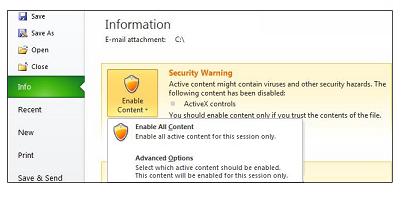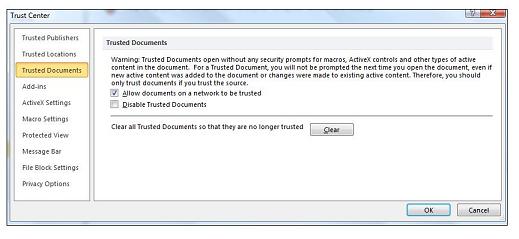
Excel for Microsoft 365 Word for Microsoft 365 PowerPoint for Microsoft 365 Access for Microsoft 365 Visio Plan 2 Excel 2021 Word 2021 PowerPoint 2021 Access 2021 Visio Professional 2021 Visio Standard 2021 Excel 2019 Word 2019 PowerPoint 2019 Access 2019 Visio Professional 2019 Visio Standard 2019 Excel 2016 Word 2016 PowerPoint 2016 Access 2016 Visio Professional 2016 Visio Standard 2016 More. Less
Last updated January 24th, 2022
What are trusted documents?Trusted documents are files that have been marked as trusted by enabling active content in them.
Active content (macros, ActiveX controls, data connections, and so on) opens without the Message Bar warning after you mark the file as trusted. For a trusted document, there is no prompt when you open the file, even if new active content was added, or changes are made to the existing active content. However, the prompt does appear if the file was moved since you last trusted the file.
After a document is trusted, it does not open in Protected View. Therefore, you should trust documents only if you trust the source of the file.
Note: If a file opens in Protected View that has no active content, and you enable editing, the file is trusted and no longer opens in Protected View. However, if the file contains active content, a Message Bar appears for the disabled active content, until you enable the content. Active content is not enabled automatically when you exit Protected View.
When you open a new file that has active content (data connections, macros, and so on) the Message Bar appears because active content may contain viruses and other security hazards that could harm your computer or your organization’s network.

However, if you trust the source of the file, or know that the active content is secure (for example, the macro is signed by a trusted publisher), then you can enable the file’s active content by selecting the Enable Content button. This makes it a trusted document. When you reopen the file, the Message Bar won't appear.
Caution: Never enable content in a document if you're not sure what that macro does. Malicious macros are often used by attackers to distribute malware.
There are situations when you can't make a file a trusted document. For example, one or several, types of active content have been disabled when you attempt to open the file. Active content can be disabled if:
To see your security settings, click the File tab. Click Options. Click Trust Center, and then click Trust Center Settings. Or you can learn more in View my options and settings in the Trust Center.
More reasons why files cannot be made trusted documentsFor these files, click Enable All Content to enable the active content for that session. This enables the content for one time, only. The Message Bar appears when you reopen the file.
The following example is an image the Security Warning area when a file cannot be trusted.

It’s important to be careful before trusting documents on a network because other people could tamper with network files and change the active content in them. To lower the possibility of security risks, you should only trust files on a network location that is access controlled or created by the system administrator.
A Security Warning dialog box appears when you try to trust a file from a network location. You can click Don't show this message again in the dialog box, and then the dialog box does not appear again. In addition, you can turn off the feature by clicking No on the Security Warning dialog box.
You can turn off the Trusted Documents feature, for network locations, in the Trust Center.

You can view or change Trusted Documents settings in the Trust Center. Making changes starts or disables the ability to create trust documents that protects your computer and your organization's network from possible malicious code in active content.